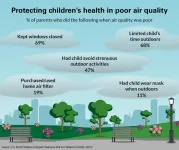(Press-News.org) Many pathogens, including the virus that causes COVID-19, are thought to have originated in wild animals before spilling into human populations.
Agriculture is often blamed for accelerating this process, which is known as zoonotic spillover, through deforestation and habitat fragmentation that reduce biodiversity and increase the likelihood of contact between infected wildlife and humans.
But in a Perspectives article published online Sept. 15 in the journal One Earth, University of Michigan ecologist Ivette Perfecto and her colleagues argue that agriculture can both help and hinder: It can act as an incubator of novel animal-borne microbes, facilitating their evolution into human-ready pathogens, or it can form barriers that help block their spread.
To prevent zoonotic spread and spillover in the future, it's important to promote agricultural practices that boost biodiversity and create pathogen barriers, while minimizing conditions that form incubators, according to the authors.
"Many people assume that agriculture is always in conflict with biodiversity conservation, but that's not always the case," said Perfecto, a professor at the U-M School for Environment and Sustainability.
"It's true that large-scale industrial monocultures are notorious for destroying biodiversity. As biodiversity declines locally, the normally species-rich collection of animals is reduced to a few species that are likely to harbor pathogens that may already be—or certainly have the potential to evolve into—pathogens that can infect humans."
For example, monocultures of corn attract large populations of mice, which tend to harbor potential zoonotic pathogens. Palm-oil plantations attract large populations of bats that feed on palm fruits. Bats and mice are generally known sources of zoonoses, defined as infections or diseases that are transmissible from animals to humans.
In contrast, landscapes with small-scale and diversified farms "are much more likely to avoid the major problems associated with industrial agriculture," said Perfecto, who, along with U-M ecologist John Vandermeer, has spent more than three decades investigating the interrelationships between biodiversity conservation, biological pest control and food sovereignty at organic coffee farms in Mexico and Puerto Rico.
When it comes to biodiversity conservation, organic shaded coffee farms beat intensive-sun coffee plantations, just as multistory agroforestry systems outperform monocultural forestry plantations.
"Right now, there is an oversimplification of the complex social reality that impacts disease spread," said study co-author Luis Chaves of Indiana University. "Most diseases are impacted by this. Why do we have transmission hotspots in certain areas but not others, despite having similar environments? It's because both landscape change and how society works as a whole matter. Understanding this and reframing our thoughts is imperative to prevent future pandemics."
In their Perspectives article, Perfecto and colleagues present a novel "agricultural matrix framework" that can be used to examine the relationship between agriculture and zoonoses. The framework distinguishes between different types of agriculture and examines how characteristics of the matrix modulate species abundance and diversity, as well as species interactions, that facilitate or inhibit the evolution of a pathogen capable of infecting humans, and the subsequent spread of that pathogen to cities.
"To minimize the emergence of zoonotic diseases, we argue that there needs to be a focus on the entire agricultural matrix across the landscape, with its attendant rules of ecological and sociopolitical drivers," Perfecto said.
The sociopolitical factors are rarely considered in ongoing debates among ecologists about disease spread. But in the 21st century, the difference between low- and high-quality agricultural matrices often has less to do with the biology of the organisms living in a landscape than the sociopolitical and economic forces at play, according to Perfecto and colleagues.
The researchers say their proposed framework can lead to coherent, practical and effective actions that address interconnected problems of food security and sovereignty, biodiversity conservation, disease emergence, climate change and poverty.
Other authors of the Perspective article in One Earth are Gordon Fitch of the University of Massachusetts, Amherst; Zachary Hajian-Forooshani, Nicholas Medina, John Vandermeer and Alexa White of the U-M Department of Ecology and Evolutionary Biology; Benjamin Iuliano of the University of Wisconsin; Kevin Li, Jonathan Morris, Iris Rivera-Salinas and Kimberly Williams-Guillén of the U-M School for Environment and Sustainability; Beatriz Otero Jiménez of the University of Central Florida; and Chenyang Su of Dartmouth College.
Part of the study was conducted by Chaves while he was a Scholar in the NIH Climate and Health Scholars Program. Chaves, Perfecto, Vandermeer and Li were partially funded by the U.S. National Science Foundation.
Study: Looking beyond land-use and land-cover change: Zoonoses emerge in the agricultural matrix
END
Incubator or barrier? Exploring the links between agriculture, biodiversity and the spread of pathogens
2023-09-18
ELSE PRESS RELEASES FROM THIS DATE:
FAU receives $750,000 philanthropic grant for Alzheimer’s disease
2023-09-18
More than 720,000 Floridians will be living with Alzheimer’s disease by 2025. Currently, Florida has the second highest prevalence of Alzheimer’s disease in the United States and is the sixth leading cause of death in Floridians 65 and older.
Although the epidemic of age-related brain dysfunction – of which Alzheimer’s disease is a major factor – is growing at an alarming rate, there is a disconnect between the existing care model designed for urgent care and the progressive nature of this chronic condition, which tends to worsen over time.
To address this widespread health concern, Florida Atlantic University’s Schmidt College ...
Study shows nearly 300% increase in ADHD medication errors
2023-09-18
(COLUMBUS, Ohio) – Attention-deficit/hyperactivity disorder (ADHD) is among the most common pediatric neurodevelopmental disorders. In 2019, nearly 10% of United States (U.S.) children had a diagnosis of ADHD. Approximately 3.3 million children, or roughly 5 out of every 100 children in the U.S., are currently prescribed medication for ADHD.
In a new study, published today in Pediatrics, researchers at the Center for Injury Research and Policy and Central Ohio Poison Center at Nationwide Children’s Hospital investigated the characteristics ...
KICT develops road pothole filtering program based on AI
2023-09-18
The Korea Institute of Civil Engineering and Building Technology (KICT, President Kim Byung-Suk) has developed a 'Road Pothole Filtering Program' to establish an emergency road restoration system for frequent pothole occurrences.
Commonly referred to as 'the landmine of the road,' potholes are a road damage phenomenon in which parts of the asphalt sink into bowl-like depressions. Potholes occur when a significant amount of rainwater infiltrates the road surface, weakening the ground below and causing the asphalt ...
New online tool available to help health care providers identify a hard to diagnose breast cancer
2023-09-18
A new diagnostic scoring system, developed by renowned breast cancer experts, is now available as an easy-to-use online tool through Susan G. Komen®, the world’s leading breast cancer organization. This tool will help health care providers recognize and effectively diagnose a rare and aggressive breast cancer, inflammatory breast cancer.
The new Inflammatory Breast Cancer (IBC) Scoring System online tool is available at https://www.komen.org/ibc and may help to increase diagnostic accuracy, predict outcomes, guide treatment decisions ...
Pearl Harbor: Bombed battleships’ boost for climate science
2023-09-18
Weather data from several ships bombed by Japanese pilots at Pearl Harbor has been recovered in a rescue mission that will help scientists understand how the global climate is changing.
Crew members aboard various vessels - such as the USS Pennsylvania and the USS Tennessee - died when their battleships were targeted in December 1941. Despite these losses, many boats returned to service during the Second World War and US naval servicemen continued their daily duties, which included recording weather data.
A new research paper, published in Geoscience Data ...
Brigham researchers uncover ‘circular logic’ of RNAs in Parkinson’s disease
2023-09-18
Investigators found and catalogued mysterious RNA circles that are linked to brain cell identity
Findings show that circular RNA is produced by brain cells damaged in Parkinson’s and Alzheimer’s disease
Circular RNA production from one Parkinson’s gene DNAJC6 was abnormal even prior to symptom onset
Researchers are gaining new insights into neurological diseases by studying circular RNAs (circRNAs) in brain cells. A new study by investigators from the Brigham and Women’s Hospital, a founding member of the Mass General ...
Engineered compound shows promise in preventing bone loss in space
2023-09-18
A new study published in a Nature Partner Journal, npj Microgravity, finds an engineered compound given to mice aboard the International Space Station (ISS) largely prevented the bone loss associated with time spent in space. The study, led by a transdisciplinary team of professors at the University of California at Los Angeles (UCLA) and the Forsyth Institute in Cambridge, Massachusetts, highlight a promising therapy to mitigate extreme bone loss from long-duration space travel as well as musculoskeletal ...
European funding for the treatment of Type 1 diabetes using 3D bioprinting
2023-09-18
Javier Ramón Azcón, an ICREA research professor and the leader of the Biosensors for Bioengineering group at the Institute for Bioengineering of Catalonia (IBEC), has been granted an "ERC Proof of Concept Grant." This prestigious grant is awarded by the European Research Council (ERC) and aims to explore the commercial and societal potential of research projects that have been previously funded by the ERC. Recipients use this type of funding to verify the practical viability of scientific concepts, explore business opportunities or prepare patent applications.
Ramón's project has been named "Uniink" and centers ...
National Poll: 2 in 3 parents say their kids have experienced poor air quality
2023-09-18
ANN ARBOR, Mich. – As smoke from Canada's historic wildfires triggers poor air quality alerts across the country, many parents worry about the impact on their child’s health, a new national poll suggests.
Two-thirds of parents say over the past two years they have experienced at least one day with poor or unhealthy air quality in their area, according to the University of Michigan Health C.S. Mott Children’s Hospital National Poll on Children’s Health.
In response to poor air quality alerts, most parents kept their windows closed and limited ...
Why do some environmental shocks lead to disaster while others don't?
2023-09-18
It's no longer just about stopping, but how we can live with climate change. To figure this out, we must delve into our cultures, as highlighted in a special issue of The Royal Society. A study by the Complexity Science Hub points out how our history could help guide the way.
Currently, we are grappling with a global crisis convergence. Various types of threats intersect, intertwine, and test our collective resilience, from climate change and economic inequality to political polarization. Although the scale and global reach of these challenges present new hurdles, these threats have been faced and, sometimes, overcome in the past. Societies today ...






